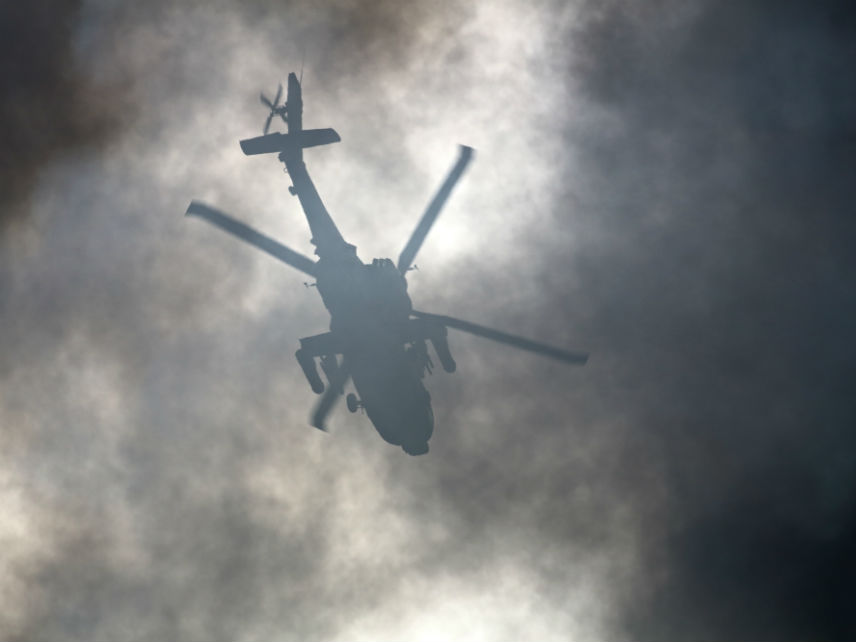What We Don't Know About U.S. Airstrikes in Somalia and Everywhere Else
The war continues and it's costing lives.

Last weekend, the U.S. military killed what they reported as 52 militants from Somalia's al-Shabab. Taking its current form in 2006, the group started crossing borders for their violence in 2012 after allying themselves with al-Qaida. Their most recent attack took place on January 15 in Kenya––gun- and explosives-wielding men killed 22 people at a hotel. Their most successful was a bomb that killed a staggering 500 people in Mogadishu in October 2017.
The U.S. has been in Somalia since 2003, and currently has about 500 troops on the ground. A drone strike killed al-Shabab's leader in 2014; however, Trump has increased airstrikes against the group along with his attacks in Afghanistan and Syria.
Somalia might bring up strong associations with Black Hawk Down and the mess of Mogadishu in 1993, but it's a conflict generally lost among more prominent debates about the legality of U.S. presence in Syria, or whether 18 years in Afghanistan might just be long enough.
President Donald Trump's regime has loosened restrictions on airstrikes, and Trump has subsequently been looser with his use of bombs. That meant a supposed removal of an alleged rule of "near-certainty" that no civilians would be killed in an attack before the US proceeded (most likely barring ones on proper battlefields like Afghanistan and Iraq), and letting military leaders especially in Afghanistan, make decisions on the ground without White House oversight. However, with the constant domestic distractions sucking up even more attention, and his abrupt threats to end wars, Trump's reputation as an actual warmonger––or at least someone happy to keep the war on terror running as briskly as ever––is underrated. Not since Obama's first years in office (who, if you can recall, was big on continuing to fight in Afghanistan) has the U.S. dropped so many bombs on Afghanistan––10,000 in the last two years, including the most powerful non-nuclear bomb.
There's nothing ambiguous about the terribleness of al-Shabab. However, experts at the Council of Foreign Relations and the Center for Strategic and International Studies attribute their more aggressive rebirth to Ethiopia's 2006 invasion of the country, which raised the terrorist group's numbers from hundreds to what is now reportedly nearing 7,000. The Somali government and the UN Security Council-backed African Union Mission in Africa have been fighting al-Shabab since 2007. Fighting them is an understandable goal, but these recent acts of violence smell like blowback and could be a teachable moment if anyone wanted to learn.
Trump's desire to kill the families of terrorists, which, if done deliberately, would likely be a violation of the Geneva Convention, was memorable, but still doesn't have the reputation of a bomb-dropping kind of guy. In part because he likes to keep enemies guessing, but also because of policy in-fighting and indecision.
Realistically, however, Barack Obama's inclination toward tying his own hands in his final years in office came after he became notorious for pioneering a drone assassination program that he refused to admit existed for years. By the time he was a lame duck, and therefore suddenly aware that someone else was going to take the reins of death soon, he decided to take control over drone strikes away from the intelligence agencies and the Pentagon. He also issued a 2016 executive order to try and catalog civilian death from drones.
Not only were Obama's lame duck attacks to clean up his own mess generally infuriating––since he set the world's precedent for drone warfare and all––but the Department of Defense and intelligence agencies under Obama were not exactly trustworthy in their civilian casualty counting skills either.
Officially, any male of military age killed in a strike counted as a terrorist until proven otherwise. Males who survive an attack are assumed to be terrorist sympathizers. Fundamentally, there has never been a reason to trust that the U.S. will tell––or even knows, or wants to know––how many civilians it kills. Yes, terrorists and locals have an incentive to claim excessive death tolls, but equally, estimates offered by the U.S. government, such as nearly 1,000 innocent people killed in three years of fighting the Islamic State (IS), will be extremely low. The nonprofit Airwars, which tracks deaths in Libya, Syria, and Iraq, frequently estimates five to six times greater numbers of civilian deaths than official U.S. accounts suggest.
Perhaps all 52 militants killed in Somalia were as bad as could be, and nobody innocent suffered. Maybe that's true, but there's hardly enough evidence to prove that the U.S. will treat gatherings of people, or cars moving towards an area deemed suspicious, or even people's homes as legitimate targets.
But again, why is the U.S. involved at all? Our military is in 170 countries around the world including 20 African countries such as Uganda, Niger, and Djibouti. Blame Trump, blame Obama, blame Bush, but that kind of presence appears to be a permanent effect of the war on terror. (Call Bill Clinton's dabbling a prequel.)
Ending wars require hard decisions and will always involve imperfect timing––it's apparently easier to continue a war than to end one. Besides, Lockheed Martin has half a billion dollars to make. We're stuck, and it's costing people's lives––sometimes soldiers, sometimes terrorists, and sometimes just terrorized civilians.


Show Comments (17)